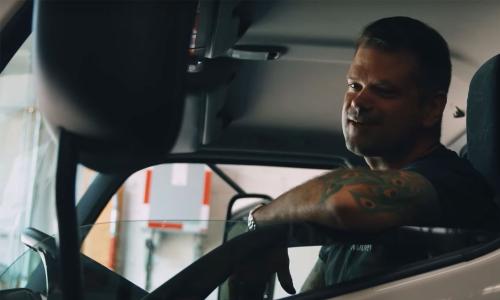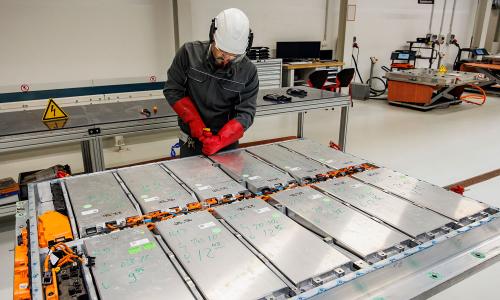When the US auto industry sells its motor vehicles, the world is a test track and a showroom. Acceleration is a virtue. Performance is a priority. Power is at a premium. And often sealing the deal is a sleek, showy style.
But when it comes to fuel economy, US automakers possess only two gears: reverse and neutral. In 2001, U.S. fuel economy plummeted to its lowest point since 1980. Technologies to improve that dismal statistic languish on the shelf, ready to be implemented but still unused. Promises of new technologies that can significantly raise the fuel economy of conventional cars and trucks are slow-tracked by manufacturers.
The 2002–2003 tug-of-war between Detroit and those who advocate leaner, cleaner vehicles was the latest battle in a decades-old struggle over fuel economy. At issue over the past year were proposed increases to the Corporate Average Fuel Economy (CAFE) standards for cars and light trucks, which have stagnated since 1985. Most recently, the National Highway Traffic Safety Administration (NHTSA) chose to raise fuel economy standards for sport utility vehicles (SUVs), minivans, and pickup trucks a mere 1.5 mpg by 2007.
From the initial debate over the 1975 CAFE standards to NHTSA’s modest fuel economy nudge in April 2003, virtually any public mention of fuel efficiency improvements has resulted in a vigorous lobbying campaign by the U.S. auto industry against such a move. The reasons offered have included: The industry would face ruin. Consumers would lose choice. Fuel economy creates safety risks for drivers.
These attacks on CAFE have been launched in the face of one indisputable fact: CAFE works. The standards imposed in the 1970s roughly doubled the fuel economy of cars within a decade, and increased truck fuel economy by about 50 percent. Furthermore, this leap was achieved without any of the automakers’ dire predictions ever coming to pass.
Yet Detroit’s campaign against CAFE continued apace, and it has worked. U.S. automakers won lengthy legislative and regulatory freezes and rollbacks of CAFE throughout the 1980s and 1990s. Economic blackmail and bogus safety scares have been the industry’s main tactics, even when these tactics sometimes cost automakers their credibility. In 1974, for example, auto executives told Congress that fuel economy standards would “outlaw” large engines and reduce all vehicles on the road to “subcompact size cars—or even smaller.”
A glance at highways in 2003, glutted with SUVs, makes such predictions look silly. But the 2002–2003 battle over CAFE seemed like déjà vu. True to form, the auto industry coupled dire predictions of collective woe for the economy and vehicle safety with a strong admonition to “go slow” on new regulation. The best current research, however, demonstrates that Detroit should be racing toward substantially higher fuel economy averages—and can accomplish this task without compromising safety.
The U.S. auto industry remains stuck in a CAFE pit stop that has lasted for more than two decades. The meager upward adjustment in CAFE standards recently mandated by NHTSA proved once again that the industry’s arguments—proven wrong on all counts over and over again—still carry tremendous clout. Loopholes for light trucks and SUVs that have steadily eroded or undermined the baseline for CAFE standards remain largely in place. In the short term (and perhaps even longer), prospects for fuel economy improvements remain dismal without a government-imposed standard that commits automakers to upping the pace at which existing technologies capable of substantially boosting fuel economy are implemented.
The irony of Detroit’s anti-CAFE campaign is that automakers do recognize the value of higher fuel economy. They continue to pledge that they will raise these standards voluntarily (while delegating CAFE bashing to their hired guns at trade associations), but history does not bear them out on this point. Improvements in fuel economy have only arrived when the public lay down challenges via their government and elected officials.
Josephine Cooper is president of the Alliance of Automobile Manufacturers, an auto industry trade group that represents the Big Three and major foreign automakers (with the notable exception of Honda). She did not equivocate when addressing the modest CAFE hikes being considered by NHTSA in 2002 and 2003: “This proposal threatens jobs, the economy and family vehicles such as SUVs and minivans, and it represents a ban on light trucks.” (1)
What was so threatening about the CAFE proposals under consideration by NHTSA? The 20.7 mpg CAFE requirement for light trucks had been in place since the mid-1990s, and the standard had been raised only 0.2 mpg from the original 1975 goals.
A 2002 report by the National Academy of Sciences (NAS) observed that technologies available to automakers could justify a substantial increase in light truck CAFE standards. Though the NAS report did not make a specific recommendation, it found that existing technologies could add as much as 12–14 mpg to cars and 11–13 mpg to trucks. (2)
This white paper will examine Detroit’s poor track record of assessing its ability to achieve fuel economy levels that could make US motor vehicles cleaner, safer, and more efficient.



